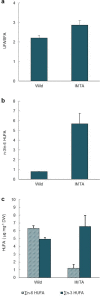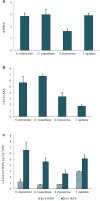Unravelling the fatty acid profiles of different polychaete species cultured under integrated multi-trophic aquaculture (IMTA)
- PMID: 34031455
- PMCID: PMC8144190
- DOI: 10.1038/s41598-021-90185-8
Unravelling the fatty acid profiles of different polychaete species cultured under integrated multi-trophic aquaculture (IMTA)
Abstract
Polychaetes can be successfully employed to recover otherwise wasted nutrients present in particulate organic matter (POM) of aquaculture effluents. The present study describes the fatty acid (FA) profile of four different polychaete species cultured in sand filters supplied with effluent water from a marine fish farm. The FA profile of cultured and wild Hediste diversicolor was compared and revealed a ≈ 24.2% dissimilarity, with cultured biomass displaying a higher content in two essential n-3 highly unsaturated FA (HUFA) (EPA [20:5 n-3] and DHA [22:6 n-3]-eicosapentaenoic and docosahexaenoic acid, respectively). The comparison of the FA profile of cultured H. diversicolor with that of other polychaete species whose larvae successfully settled on the sand filters (Diopatra neapolitana, Sabella cf. pavonina and Terebella lapidaria) revealed that their FA profile, which is here described for the first time, displayed high levels of EPA and DHA (≈ 1.5-4.8 and 1.0-1.1 µg mg-1 DW, respectively). The highest concentration of total FA per biomass of polychaete was recorded in H. diversicolor and T. lapidaria, with both species being the ones whose FA profiles revealed a lowest level of dissimilarity and more closely resembled that of the aquafeed used in the fish farm. In the present work it was demonstrated that it is possible to produce polychaetes biomass with high nutritional value through an eco-design concept such as integrated multi-trophic aquaculture (IMTA). Indeed, this framework promotes a cleaner production and, in this specific case, allowed to recover essential fatty acids that are commonly wasted in aquaculture effluents.
Conflict of interest statement
The authors declare no competing interests.
Figures





Similar articles
-
Performance of polychaete assisted sand filters under contrasting nutrient loads in an integrated multi-trophic aquaculture (IMTA) system.Sci Rep. 2020 Nov 30;10(1):20871. doi: 10.1038/s41598-020-77764-x. Sci Rep. 2020. PMID: 33257745 Free PMC article.
-
Effect of High-Pressure Processing (HPP) on the Fatty Acid Profile of Different Sized Ragworms (Hediste diversicolor) Cultured in an Integrated Multi-Trophic Aquaculture (IMTA) System.Molecules. 2019 Dec 9;24(24):4503. doi: 10.3390/molecules24244503. Molecules. 2019. PMID: 31835345 Free PMC article.
-
New species for the biomitigation of a super-intensive marine fish farm effluent: Combined use of polychaete-assisted sand filters and halophyte aquaponics.Sci Total Environ. 2017 Dec 1;599-600:1922-1928. doi: 10.1016/j.scitotenv.2017.05.121. Epub 2017 May 21. Sci Total Environ. 2017. PMID: 28545219
-
Regional Integrated Multi-Trophic Aquaculture (RIMTA): Spatially separated, ecologically linked.J Environ Manage. 2020 Oct 1;271:110921. doi: 10.1016/j.jenvman.2020.110921. Epub 2020 Jun 24. J Environ Manage. 2020. PMID: 32579516 Review.
-
Are fish what they eat? A fatty acid's perspective.Prog Lipid Res. 2020 Nov;80:101064. doi: 10.1016/j.plipres.2020.101064. Epub 2020 Sep 30. Prog Lipid Res. 2020. PMID: 33010278
Cited by
-
Combined Use of Fatty Acid Profiles and Elemental Fingerprints to Trace the Geographic Origin of Live Baits for Sports Fishing: The Solitary Tube Worm (Diopatra neapolitana, Annelida, Onuphidae) as a Case Study.Animals (Basel). 2024 Apr 30;14(9):1361. doi: 10.3390/ani14091361. Animals (Basel). 2024. PMID: 38731365 Free PMC article.
-
Polychaete (Alitta virens) meal inclusion as a dietary strategy for modulating gut microbiota of European seabass (Dicentrarchus labrax).Front Immunol. 2023 Dec 11;14:1266947. doi: 10.3389/fimmu.2023.1266947. eCollection 2023. Front Immunol. 2023. PMID: 38152403 Free PMC article.
-
Effect of three polychaetes on growth and reproductive performance, biochemical indices and histology of different tissues in the female Pacific white shrimp, Litopenaeus vannamei broodstock.Anim Nutr. 2025 Jan 20;21:49-62. doi: 10.1016/j.aninu.2024.11.020. eCollection 2025 Jun. Anim Nutr. 2025. PMID: 40292183 Free PMC article.
-
Metabolomic Profile and Biological Properties of Sea Lavender (Limonium algarvense Erben) Plants Cultivated with Aquaculture Wastewaters: Implications for Its Use in Herbal Formulations and Food Additives.Foods. 2021 Dec 14;10(12):3104. doi: 10.3390/foods10123104. Foods. 2021. PMID: 34945654 Free PMC article.
References
-
- FAO. The State of World Fisheries and Aquaculture—Meeting the Sustainable Development Goals (Food and Agriculture Organization of the United Nations, 2018).
-
- EFSA Scientific opinion on the tolerable upper intake level of eicosapentaenoic acid (EPA), docosahexaenoic acid (DHA) and docosapentaenoic acid (DPA) EFSA J. 2012;10(7):1–48.
-
- Tocher DR. Omega-3 long-chain polyunsaturated fatty acids and aquaculture in perspective. Aquaculture. 2015;449:94–107. doi: 10.1016/j.aquaculture.2015.01.010. - DOI
Publication types
MeSH terms
Substances
LinkOut - more resources
Full Text Sources
Other Literature Sources
Research Materials

